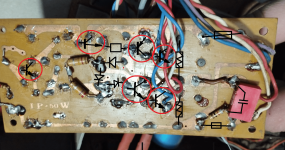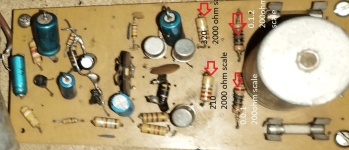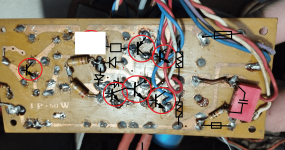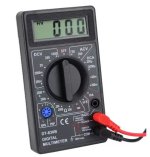Is the amplifier stereo or mono? If it's a stereo amplifier, are both channels damaged?
I see two fuses on the board, what are their ratings and are they okay? Are there any other fuses inside the amplifier not shown in the picture?

I see two fuses on the board, what are their ratings and are they okay? Are there any other fuses inside the amplifier not shown in the picture?
You can test the theory of the first picture in post 121 with a working diode scale of the DVM. The diode symbols, you should get 500-700 forwards (black probe to line), 9999 or ---- backwards. The line of the transistor symbols is the base. The leg with the arrow on it is the emitter. If your meter reads 400, the battery is bad or the DVM is bad.
Are there any other fuses inside the amplifier not shown in the picture? Can you post a picture of the internals of the amplifier, including the transformer and rectifier?
transformer has one or two i think but i don't see rectifier maybe is attached to transformer i am not sure. but i dont know why that is important
my meter is new and battery is new its cheap one but i think it works . here is picture of it. i dont really want to spend money on pro multimeter here its no so cheap. and i just need it sometimes as i said before i dont do electronics as my job xdd i am music producer actually xd this is something i like to do for fun mostly.You can test the theory of the first picture in post 121 with a working diode scale of the DVM. The diode symbols, you should get 500-700 forwards (black probe to line), 9999 or ---- backwards. The line of the transistor symbols is the base. The leg with the arrow on it is the emitter. If your meter reads 400, the battery is bad or the DVM is bad.
Attachments
Some cheap meters are garbage. You can prove diode scale is good or useless by checking a diode. If you get the wrong answers, this meter is garbage. You can check the DC volts scale with a new AA or D cell battery. Should read 1.55 to 1.6 v.
This is important because we need to know if the power supply is dual rail or single rail, more information will help the diagnosis.transformer has one or two i think but i don't see rectifier maybe is attached to transformer i am not sure. but i dont know why that is important
You need to measure a diode that is not blown up to prove your meter is a decoration or a test insrument. 500-700 forwards, 9999 or ----- backwards are the right answer. A rectifier is a diode for substantial current, usually over 1.5 amp. Wrong answer, throw the meter away and replace it.transformer has one or two i think but i don't see rectifier maybe is attached to transformer i am not sure. but i dont know why that is important
only two wires come from power supplyThis is important because we need to know if the power supply is dual rail or single rail, more information will help the diagnosis.
i have soem diodes i will check it and will let you know if it shows good readingYou need to measure a diode that is not blown up to prove your meter is a decoration or a test insrument. 500-700 forwards, 9999 or ----- backwards are the right answer. A rectifier is a diode for substantial current, usually over 1.5 amp. Wrong answer, throw the meter away and replace it.
Please check all 6 transistors with your multimeter for the presence of two diodes in them..is this right ?
Last edited:
https://inclinedfidelity.com/product/ip-50-ampflifier/
Not every application requires massive amounts of power. Sometimes the clarity, detail, and imaging of an amplifier is why you choose it. That is often the case with the IP-50. Featuring an ICEPower amplifier module providing 50 watts to each stereo channel at 4 ohms and 25 watts to each channel at 8 ohms. With an audiophile-grade performance, this amp is equally at home in your studio or your living room. Featuring gold plated banana plugs for speaker outs and XLR inputs. Comes in a milled aluminum Ghent audio case.
Only 1 left in stock (can be backordered)

IP-50 Ampflifier
$399.99Not every application requires massive amounts of power. Sometimes the clarity, detail, and imaging of an amplifier is why you choose it. That is often the case with the IP-50. Featuring an ICEPower amplifier module providing 50 watts to each stereo channel at 4 ohms and 25 watts to each channel at 8 ohms. With an audiophile-grade performance, this amp is equally at home in your studio or your living room. Featuring gold plated banana plugs for speaker outs and XLR inputs. Comes in a milled aluminum Ghent audio case.
Only 1 left in stock (can be backordered)
Wakh, OP is looking to repair the amp for sentimental reasons, and not aiming to buy a new one.
Hugo
Hugo
You need to label the transistors and diodes and make a table of readings. Q1 is obviously the little black transistor near one end. The base of that goes to the input capacitor. Next to the right is Q2. Of the 4 to the right, some are connected to the lower black rail (black? look at the big blue capacitor labels for minus), make those even #, some are connected more to the plus rail (white) make those odd numbers. Of the two output transistors, make the one closer to minus Q6. Label the board with a permanent marker, ours are branded "sharpie". Make up a table with the transistor numbers in order, E B & C for each, take diode scale readings forwards & backwards and write them down. Please report. On 1 cm diameter transistors emitter is the lead closest to the tab. The two diodes are probably between the bases of the drivers (that connect to the output transistors, the TO3 ones 2.5 cm long on the aluminum angle.
All transistors showing opens ---- or shorts 0001 should be replaced. I found TO39 transistors at digikey. You need Vce of 50 to 100 v for a 50 w amp with 2n3055 outputs. Probably your rail voltage is 40 to 75. Suitable ones in stock at digikey minnesota are npn 2n3019 2n2102 2n5320 2n2405 and pnp 2n4033 and 2n5322.
Not all transistors showing b-e and c-e of 500-700 are good, some can collapse to zero volts with rail voltage on them. These you will have to detect with a voltage test after you build the light bulb box to power up the amp.
All transistors showing opens ---- or shorts 0001 should be replaced. I found TO39 transistors at digikey. You need Vce of 50 to 100 v for a 50 w amp with 2n3055 outputs. Probably your rail voltage is 40 to 75. Suitable ones in stock at digikey minnesota are npn 2n3019 2n2102 2n5320 2n2405 and pnp 2n4033 and 2n5322.
Not all transistors showing b-e and c-e of 500-700 are good, some can collapse to zero volts with rail voltage on them. These you will have to detect with a voltage test after you build the light bulb box to power up the amp.
- Home
- Amplifiers
- Solid State
- transistor amp not working after shorting output



